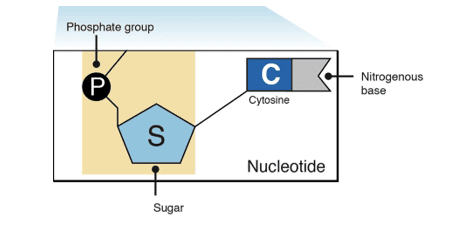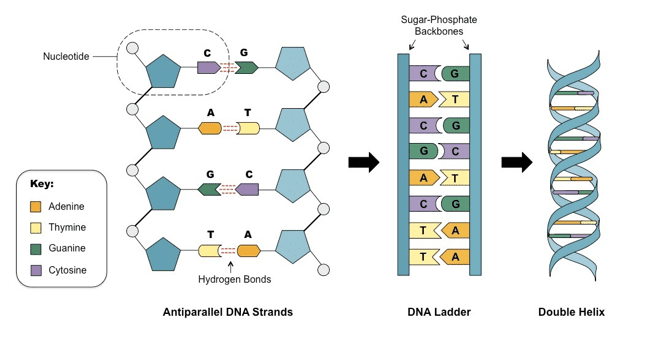In this post
Genes and DNA
With the exception of red blood cells and fat cells, all eukaryotic cells contain a nucleus which itself contains pairs of chromosomes. One chromosome in each pair comes from the mother and the other chromosome in each pair comes from the father.
Different organisms have a different number of pairs of chromosomes within their cell’s nucleus. For example, human cells have 23 pairs of chromosomes whereas dog cells have 39 pairs and horse cells have 32 pairs.
Chromosomes are long coiled up molecules of a polymer known as deoxyribonucleic acid or DNA for short. DNA is itself made up of small sections known as genes which are pieces of coded information used to determine your inherited characteristics. Each chromosome contains thousands of genes, which all code for a specific protein.
The genome is the entire genetic material contained within an organism. This includes all the deoxyribonucleic acid (DNA) found in the chromosomes in the nucleus of body cells as well as that which is found in the mitochondria of the cells.
The human genome contains almost 21,000 genes which all code for different proteins.
Structure of DNA
DNA is a polymer molecule made up of two strands coiled around each other to form a double helix shape. Each strand of DNA is made up of lots of monomers or repeating units known as nucleotides. Each single nucleotide is made up of a sugar molecule, a phosphate molecule and a base, as shown in the following diagram:

There are four different bases which can join to the sugar molecule in each nucleotide. These bases are adenine (A), cytosine (C), guanine (G) and thymine (T).
The sugar molecule and phosphate molecules form the ‘backbone’ of the DNA strands and the two strands are linked together in their double helix shape by a series of complementary pairing of the bases through hydrogen bonding, as shown in the following diagram:

The complementary base pairing pattern means that A will only ever pair with T and C will only pair up with G.
RNA structure
Ribonucleic acid (RNA) is a polymer made in the nucleus of the cell but moves out of the nucleus through the nuclear membrane and is found mainly in the cell’s cytoplasm.
RNA molecules differ from DNA in that they are single stranded and contain the base uracil (U) instead of thymine. In RNA the base pairing therefore also differs slightly. Although C still pairs up with G, A pairs up with U instead of T.
Protein synthesis
Proteins are polymers made up of amino acids. Different proteins have specific functions in our body but generally proteins are needed for the growth and repair of cells and tissues. Each individual protein is made up of a specific number and sequence of amino acids.
It is the order of the bases within the DNA molecule which determines the order of the amino acids, and therefore the structure and function of the protein produced.
Each amino acid has an individual sequence of three bases in a gene. This sequence is known as a base triplet. For example, the amino acid lysine has a base triplet TTC whereas the amino acid cysteine has a base triplet ACA.
There are two stages in the process of protein synthesis – transcription and translation. Proteins are made by sub-cellular structures called ribosomes which are found in the cytoplasm of the cell. In order for the ribosomes to be able to produce the protein, the coding information from the sequence of bases on the DNA molecule must be extracted. As the DNA molecule is too large to move through the nuclear membrane and out of the nucleus, a smaller molecule must be used which can move into the nucleus to retrieve the information from the DNA and back out of the nucleus to travel to the ribosomes where the information can be used.
These small molecules are known as messenger RNA (mRNA). The mRNA is a single strand of nucleotides which contains the base uracil (U) instead of thymine (T).
Transcription
Transcription is the first stage of protein synthesis which takes place in the cell nucleus by the following stages:
1) The enzyme RNA polymerase binds to part of the DNA in front of the required gene. As the enzyme moves along it causes the two DNA strands to ‘unzip’ as the hydrogen bonds between the paired bases break.
2) In the nucleus of the cell there are free RNA nucleotides which are then able to form complementary base pairs with one of the single strand strands of DNA. Remember that RNA contains U instead of T so it is complementary base pairing between A on the DNA that occurs with U on the RNA strand. C and G bases on each strand pair up the same.
3) Hydrogen bonds form between the complementary base pairs on the RNA and DNA strands and bonds also form between the sugar and phosphate molecules on the neighbouring RNA nucleotides. This bonding results in the formation of a strand of messenger RNA (mRNA).
4) Once the strand of mRNA has been completed, a sequence called a terminator signals that the transcription is complete.
5) The mRNA is released from the DNA strand. It travels out of the nucleus and into the cytoplasm where it can join up with a ribosome ready for the next stage of the process, translation.
Translation
Translation is the second stage in the process of protein synthesis which takes place on the ribosomes in the cytoplasm of the cell.
1) Amino acids are carried to the ribosome by another type of RNA molecule known as transfer RNA (tRNA).
2) The amino acids are brought to the ribosomes in the order matching the order of base triplets in the mRNA strand. In mRNA these base triplets are also known as codons.
3) Part of the structure of tRNA is known as an anticodon. The anticodon sequence is complementary to the codon for each amino acid. The complementary base pairing of the codon and anticodon ensures that the amino acids are brought to the ribosome and processed in the correct order.
4) Each of the amino acids is then joined together at the ribosome in a long chain to form a protein or polypeptide.
Genes and alleles
Chromosomes are found in the nucleus of a cell in pairs. One chromosome in each pair comes from the sperm cell of the father and the other chromosome comes from the egg cell of the mother. The chromosomes from each parent will both have genes for characteristics such as eye colour and hair colour, as well as genetic disorders such as cystic fibrosis or Huntington’s chorea.
Alleles
For every gene in an organism there are two different versions of that gene as there is one on the chromosome from the father and another on the chromosome from the mother

For example, the gene for hair colour from the mother may be that for blonde hair, whereas the gene for hair colour from the father may be that for red hair. These alternative forms of the same gene are known as alleles and they give rise to the differences in inherited characteristics in an organism.
The physical appearance of an organism for an inherited characteristic is known as the phenotype of the organism. Most phenotypic features such as eye colour, skin colour and hair colour, are the result of polygenic inheritance rather than single genes. This means that the phenotype is determined by more than one gene. The organism’s phenotype depends upon the combination of alleles from both the mother and father, which may be the same or different alleles. For example, there are different alleles for eye colour including alleles for blue eyes and brown eyes.
The genetic make-up or alleles present in the individual for any given inherited characteristic is known as the genotype of the organism. We represent alleles using letters, so the genotype of an organism is represented by the combination of two letters representing the two alleles inherited from both parents. These two letters may be both capital letters, both lower case letters or a combination of one capital letter and one lower case letter.
Dominant alleles
Some alleles will always be expressed in an organism’s phenotype regardless of the other allele present in the pair. These alleles are known as dominant. A dominant allele will always determine the phenotype of the organism even if there is only one copy of the allele present.
Dominant alleles are always represented using a capital letter. For example, the allele for brown eyes is dominant. We would represent this allele using B. If the organism inherits the brown allele from only one parent, they will still have brown eyes regardless of the allele for eye colour inherited from the other parent.

Recessive alleles
Some alleles will only be expressed in a phenotype if there is no dominant allele present. These alleles are known as recessive. The phenotype for a recessive gene will only be observed if there are two copies of the recessive allele present in the organism’s genotype.
Recessive alleles are always represented using lower case letters. For example, the allele for blue eyes is recessive and is represented using b. An organism will only have blue eyes if the allele has been inherited from both parents and there is no allele for brown eyes present. An organism’s genotype containing two identical alleles for a given characteristic is known as homozygous. For example, the genotypes BB and bb are both homozygous. A heterozygous genotype contains different alleles for a given characteristic. For example, the genotype Bb is heterozygous.




